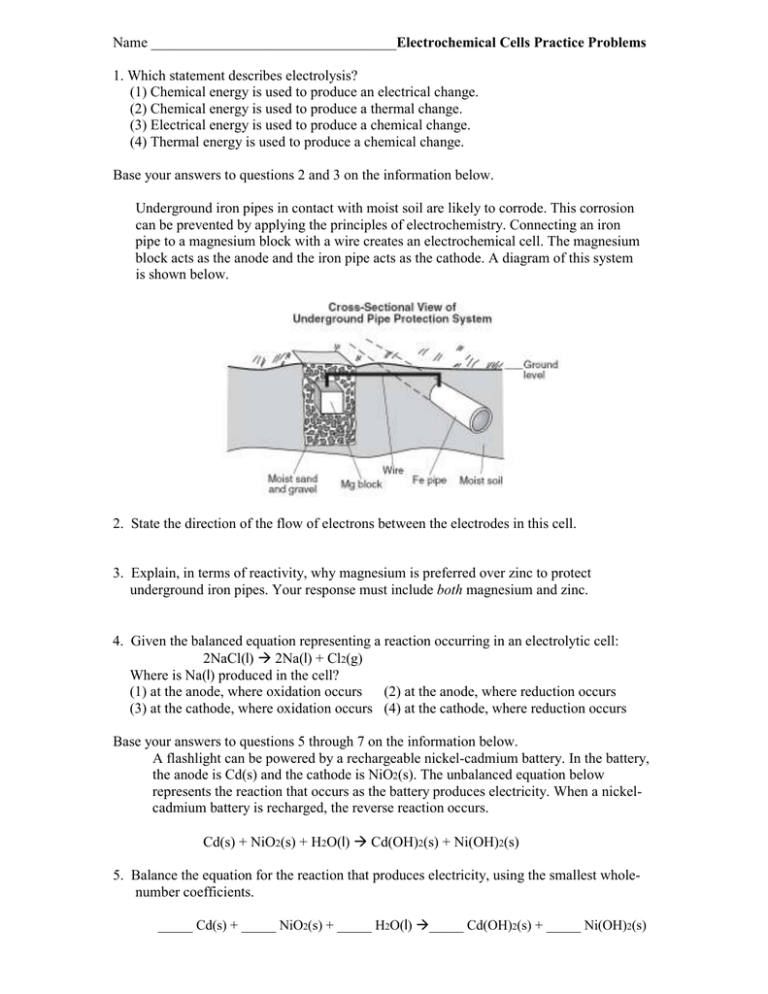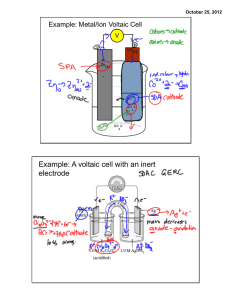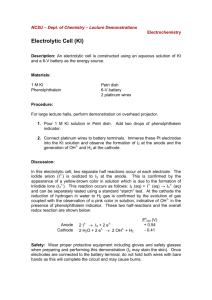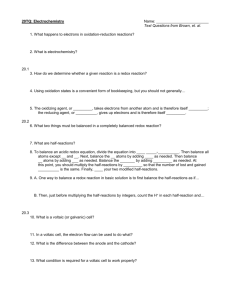practice problems - electrochemical cell
advertisement

Name __________________________________Electrochemical Cells Practice Problems 1. Which statement describes electrolysis? (1) Chemical energy is used to produce an electrical change. (2) Chemical energy is used to produce a thermal change. (3) Electrical energy is used to produce a chemical change. (4) Thermal energy is used to produce a chemical change. Base your answers to questions 2 and 3 on the information below. Underground iron pipes in contact with moist soil are likely to corrode. This corrosion can be prevented by applying the principles of electrochemistry. Connecting an iron pipe to a magnesium block with a wire creates an electrochemical cell. The magnesium block acts as the anode and the iron pipe acts as the cathode. A diagram of this system is shown below. 2. State the direction of the flow of electrons between the electrodes in this cell. 3. Explain, in terms of reactivity, why magnesium is preferred over zinc to protect underground iron pipes. Your response must include both magnesium and zinc. 4. Given the balanced equation representing a reaction occurring in an electrolytic cell: 2NaCl(l) 2Na(l) + Cl2(g) Where is Na(l) produced in the cell? (1) at the anode, where oxidation occurs (2) at the anode, where reduction occurs (3) at the cathode, where oxidation occurs (4) at the cathode, where reduction occurs Base your answers to questions 5 through 7 on the information below. A flashlight can be powered by a rechargeable nickel-cadmium battery. In the battery, the anode is Cd(s) and the cathode is NiO2(s). The unbalanced equation below represents the reaction that occurs as the battery produces electricity. When a nickelcadmium battery is recharged, the reverse reaction occurs. Cd(s) + NiO2(s) + H2O(l) Cd(OH)2(s) + Ni(OH)2(s) 5. Balance the equation for the reaction that produces electricity, using the smallest wholenumber coefficients. _____ Cd(s) + _____ NiO2(s) + _____ H2O(l) _____ Cd(OH)2(s) + _____ Ni(OH)2(s) 6. Determine the change in oxidation number for the element that makes up the anode in the reaction that produces electricity. 7. Explain why Cd would be above Ni if placed on Table J. 8. Which energy conversion occurs in a voltaic cell? (1) chemical energy to electrical energy (2) chemical energy to nuclear energy (3) electrical energy to chemical energy (4) nuclear energy to electrical energy 9. Which metal is more active than Ni and less active than Zn? (1) Cu (2) Cr (3) Mg (4) Pb 10. Reduction occurs at the cathode in (1) electrolytic cells, only (2) voltaic cells, only (3) both electrolytic cells and voltaic cells (4) neither electrolytic cells nor voltaic cells 11. Given the balanced equation representing the reaction occurring in a voltaic cell: Zn(s) + Pb2+(aq) Zn2+(aq) + Pb(s) In the completed external circuit, the electrons flow from (1) Pb(s) to Zn(s) (2) Pb2+(aq) to Zn2+(aq) (3) Zn(s) to Pb(s) (4) Zn2+(aq) to Pb2+(aq) Base your answers to questions 12 and 13 on the information below. Electroplating is an electrolytic process used to coat metal objects with a more expensive and less reactive metal. The diagram below shows an electroplating cell that includes a battery connected to a silver bar and a metal spoon. The bar and spoon are submerged in AgNO3(aq). 12. Explain why AgNO3 is a better choice than AgCl for use in this electrolytic process. 13. Explain the purpose of the battery in this cell. 14. Which energy conversion occurs during the operation of a voltaic cell? (1) Chemical energy is spontaneously converted to electrical energy. (2) Chemical energy is converted to electrical energy only when an external power source is provided. (3) Electrical energy is spontaneously converted to chemical energy. (4) Electrical energy is converted to chemical energy only when an external power source is provided. 15. Based on Reference Table J, identify one metal that does not react spontaneously with HCl. Base your answers to questions 16 through 18 on the diagram below. The diagram shows a voltaic cell with copper and aluminum electrodes immediately after the external circuit is completed. 16. Balance the redox equation using the smallest whole-number coefficients. _____Cu2+(aq) + _____Al(s) _______Cu(s) + _____Al3+(aq) 17. As this voltaic cell operates, the mass of the Al(s) electrode decreases. Explain, in terms of particles, why this decrease in mass occurs. 18. Explain the function of the salt bridge. 19. Which conversion of energy always occurs in a voltaic cell? (1) light energy to chemical energy (2) electrical energy to chemical energy (3) chemical energy to light energy (4) chemical energy to electrical energy 20. Which process occurs at the anode in an electrochemical cell? (1) the loss of protons (2) the loss of electrons (3) the gain of protons (4) the gain of electrons 21. Examine the reaction: Fe(s) + 2HNO3(aq) Fe(NO3)2(aq) + H2(g) Explain in terms of activity why this reaction is spontaneous. 22. Because tap water is slightly acidic, water pipes made of iron corrode over time, as shown by the balanced ionic equation below: 2Fe + 6H+ 2Fe3+ + 3H2 Explain, in terms of chemical reactivity, why copper pipes are less likely to corrode than iron pipes. Base your answers to questions 23 and 24 on the information and diagram below. The apparatus shown in the diagram consists of two inert platinum electrodes immersed in water. A small amount of an electrolyte, H2SO4, must be added to the water for the reaction to take place. The electrodes are connected to a source that supplies electricity. 23. What type of electrochemical cell is shown? 24. What particles provided by the electrolyte allow an electric current to flow? Electrochemical Cells Practice Problems – Answer Key 1. 2. 3. 4. 5. 6. 7. 8. 9. 10. 11. 12. 13. 14. 15. 16. 17. 18. 19. 20. 21. 22. 23. 24. (3) From Mg to Fe Mg will donate e- more readily than Zn helping Fe fight oxidation better (4) 1, 1, 2, 1, 1 Increases from 0 to +2 Cd replaces Ni in the compound which means Cd is more active/reactive than Ni (1) (2) (3) (3) AgCl is not soluble To provide energy to force e- to the cathode (or the metal spoon) (4) Cu, Ag, Au 3, 2, 3, 2 Al(s) (or Al0) loses e- (is oxidized) forming Al3+ ions which “fall off” electrode into solution To allow restricted ion flow; prevent charge build-up; allow ions to move between cells (4) (2) Fe is more active/reactive than H2 Cu is less active/reactive than H2, so Cu will not be oxidized by the acid Electrolytic Ions





